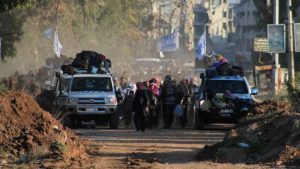Has the international community failed Syria?
by Fakhri Mansour. Fakhri will be on the panel for our What next for Syria? event on 30 November 2016.
According to the humanitarian actors in Syria there are 13.5 million people across Syria in need of some sort of assistance including 861,200 people trapped in 18 besieged locations and around 4.5 million people living in hard-to-reach areas. It is also estimated that life expectancy in Syria has dropped by more than 20 years since the onset of the conflict in 2011, which was accompanied by a rapid economic decline, currency depreciation, and widespread damage to infrastructure and essential education and healthcare facilities leaving 3 in 4 people living in poverty, more than 2 million children out of schools, and around half of the population with no access to basic health services. It is no surprise that this sad reality has triggered civilians to flee Syria, creating the worst refugee crisis since World War II with about 4.8 million refugees registered with the UN Refugee Agency (UNHCR) in Syria’s neighbouring countries and north Africa as of 7 November 2016.
As the violence continues unabated across Syria, the above-mentioned figures are being regularly updated by the humanitarian actors in Syria reflecting an increasingly gloomy situation. However, the international community seems not even close to understanding the scale and scope of the crisis, despite its inflammatory nature which is causing regional spillover effects. In fact, the two unanimously adopted Security Council Resolutions 2139 (2014) and 2165 (2014) have generated humanitarian breakthrough by enabling humanitarian actors to have complementary modalities to deliver aid, namely the cross-border and the cross-line relief operations, but these resolutions are designed for humanitarian objectives and do not fall within the scope of the political aspects which clearly indicates that the international community is trying to respond to the humanitarian consequences of the conflict without addressing the root causes. Now, after two years of adopting these resolutions, it is evident that the designated humanitarian modalities continue to be paralysed by a number of factors, mostly political in nature, such as active conflict, lack of funds and unilateral international sanctions, politicisation of aid by parties to the conflict, and the increasing insecurity and violence. The political deadlock is fuelling tension and violence which did not spare even the aid workers in Syria as dozens of them have been killed including, most recently on 19 September 2016, 18 members of the Syrian Arab Red Crescent (SARC) in the aftermath of the attack on the UN/SARC joint humanitarian convoy to Urem Al-Kubra in the western countryside of Aleppo.
The deadly attacks on aid workers in Syria prove that even humanitarian actors are not immune from the ongoing violence and that the humanitarian catastrophe in Syria will not be resolved by humanitarian responses, no matter how many cross-border and cross-line relief operations will be carried out, not only because such relief efforts are exposed to growing insecurity, but also because the human tragedy in Syria is being observed by the Security Council with a staggering degree of inability and unwillingness to politically resolve the conflict which emboldened the warring parties to continue showing total disregard to civilian life. As the conflict is approaching its 7th year, there is no doubt that the humanitarian responses will continue to be a lifeline for millions of affected people, but the international community cannot afford to let the crisis in Syria fall through the cracks and focus only on responding to the humanitarian needs when even the humanitarian actors themselves are in danger.
Having personally coordinated and participated in many humanitarian operations in Syria, particularly in besieged and hard-to-reach areas, I recall a specific field mission which fits the context here; as we were driving into a besieged town in rural Damascus – which used to be a summer resort with a vibrant market before witnessing months of the worst fighting in the conflict – the residence of the towns received the humanitarian convoy with fireworks. This special reception of the convoy signals the eagerness of the people not only to receive the humanitarian assistance, but most significantly to demonstrate a sense of joy, hope and normality driven by the calm and peace which this town has enjoyed temporarily during the implementation of the convoy. Ultimately, Syrians have never given up hope for lasting peace, not only temporary peace, thus humanitarian activities can deal only with the symptoms of the conflict without guarantees that the symptoms will not be worse which requires the Security Council to collectively exercise its responsibility as the failure to do so will result most likely in having another “Never Again” speech!
Fakhri will be on the panel for our What next for Syria? event on 30 November 2016. Register for a free place via Eventbrite.



0 Comments